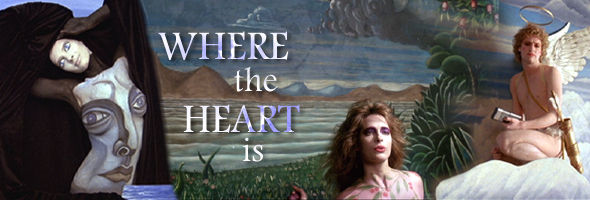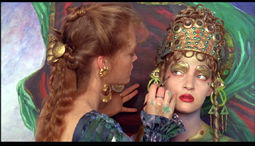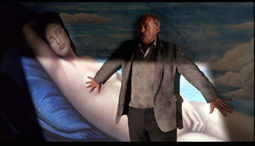
Colour, 1990, 107m. / Directed by John Boorman / Starring Dabney Coleman, Uma Thurman / Buena Vista (US R1 NTSC) / WS (1.85:1) (16:9) / DD2.0
Misleadingly promoted as a goofball comedy, this stylish fable from director Boorman (fresh off his masterpiece, Hope and Glory) suffered at the hands of confused critics and went almost directly to cable and video, If ever a film demonstrated the need for letterboxing an open matte transfer, this is it. Prior full frame editions of this film (VHS, laserdisc, cable) contained all of the exposed film information on each side of the frame, which ruins several carefully mounted images by revealing the edges of canvases, distracting light fixtures, and other visual ephemera that knocks the compositions off-kilter. The DVD finally restores the original framing and looks quite nice, featuring extremely vivid colors and richer blacks than before. Surrounds are restrained almost entirely to the musical score. The budget-priced disc features no extras and very bland packaging.
In a fairy tale version of New York, real estate fat cat Stewart McBain (Coleman) gets his only thrills in life from demolishing buildings. Annoyed by his pampered, post-adolescent children who refuse to leave the nest, McBain finally deposits them one rainy night to live at the Dutch House, a decrepit architectural landmark under McBain's control.
 "You can't just spoil us and then stop spoiling us whenver it pleases you," complains young Daphne (Thurman), while artistic older sister Chloe (Suzy Amis) finds solace in creating a possibly lucrative calendar from the striking trompe l'oeuil tableux she perfected in art school, creating optical illusions by painting on human bodies and the walls behind them. Young brother Jimmy (Cube's David Hewlett) gets to work creating video games, and soon the house is filled with an eccentric assortment of characters: shameless yuppie Tom (Dylan Walsh), sexy speaker-in-tongues Sheryl (Sheila Kelly), gay fashion designer Lionel (Crispin Glover), and a homeless former magician, Shitty (Christopher Plummer, who probably leaves that character name off his resumé). Romance, twists of fate and acts of God result in a narrative whirlwind which places all of the characters under one roof with destinies far different than they expected.
"You can't just spoil us and then stop spoiling us whenver it pleases you," complains young Daphne (Thurman), while artistic older sister Chloe (Suzy Amis) finds solace in creating a possibly lucrative calendar from the striking trompe l'oeuil tableux she perfected in art school, creating optical illusions by painting on human bodies and the walls behind them. Young brother Jimmy (Cube's David Hewlett) gets to work creating video games, and soon the house is filled with an eccentric assortment of characters: shameless yuppie Tom (Dylan Walsh), sexy speaker-in-tongues Sheryl (Sheila Kelly), gay fashion designer Lionel (Crispin Glover), and a homeless former magician, Shitty (Christopher Plummer, who probably leaves that character name off his resumé). Romance, twists of fate and acts of God result in a narrative whirlwind which places all of the characters under one roof with destinies far different than they expected.
 where it finally amassed a small but devoted cult following. The film is a visual feast throughout, packing each frame with dazzling tricks of light and color, and fits nicely into the tradition of whimsical moral plays which dot American cinema history dating back to Frank Capra, Ernst Lubitsch and Preston Sturges. Of course modern audiences don't respond well to sincere artifice without irony (see the unjustly maligned Joe versus the Volcano, with which this would make an ideal double bill, or Boorman's similar second film, Leo the Last), so this film's effectiveness will depend entirely on the viewer's willingness to go along with its anachronistic tone. The combination of surreal imagery, airy music and mannered performances creates one of Boorman's more accessible films. The end product isn't a classic thanks to a few stumbles, namely some gratuitous mugging from Coleman and a pat final scene that confusingly shifts several characters' motivations and personalities with no explanation. One could also argue that this tactic is Boorman's nose-thumbing at the convenient wrap-ups found in traditional Hollywood comedies, but for whatever reason, it's only a minor blemish on an otherwise beautiful canvas. Since this was mostly shot in
where it finally amassed a small but devoted cult following. The film is a visual feast throughout, packing each frame with dazzling tricks of light and color, and fits nicely into the tradition of whimsical moral plays which dot American cinema history dating back to Frank Capra, Ernst Lubitsch and Preston Sturges. Of course modern audiences don't respond well to sincere artifice without irony (see the unjustly maligned Joe versus the Volcano, with which this would make an ideal double bill, or Boorman's similar second film, Leo the Last), so this film's effectiveness will depend entirely on the viewer's willingness to go along with its anachronistic tone. The combination of surreal imagery, airy music and mannered performances creates one of Boorman's more accessible films. The end product isn't a classic thanks to a few stumbles, namely some gratuitous mugging from Coleman and a pat final scene that confusingly shifts several characters' motivations and personalities with no explanation. One could also argue that this tactic is Boorman's nose-thumbing at the convenient wrap-ups found in traditional Hollywood comedies, but for whatever reason, it's only a minor blemish on an otherwise beautiful canvas. Since this was mostly shot in  Toronto (which explains why it doesn't really feel like New York), many familiar names from David Cronenberg films turn up, namely cinematographer Peter Suschitzky, production designer Carol Spier, and art director James McAteer; all three work perfectly together to craft a visual look unlike any other. And for you skin watchers, yes, Uma and Suzy spend much of their screen time in their birthday suits, albeit covered in body paint.
Toronto (which explains why it doesn't really feel like New York), many familiar names from David Cronenberg films turn up, namely cinematographer Peter Suschitzky, production designer Carol Spier, and art director James McAteer; all three work perfectly together to craft a visual look unlike any other. And for you skin watchers, yes, Uma and Suzy spend much of their screen time in their birthday suits, albeit covered in body paint.
